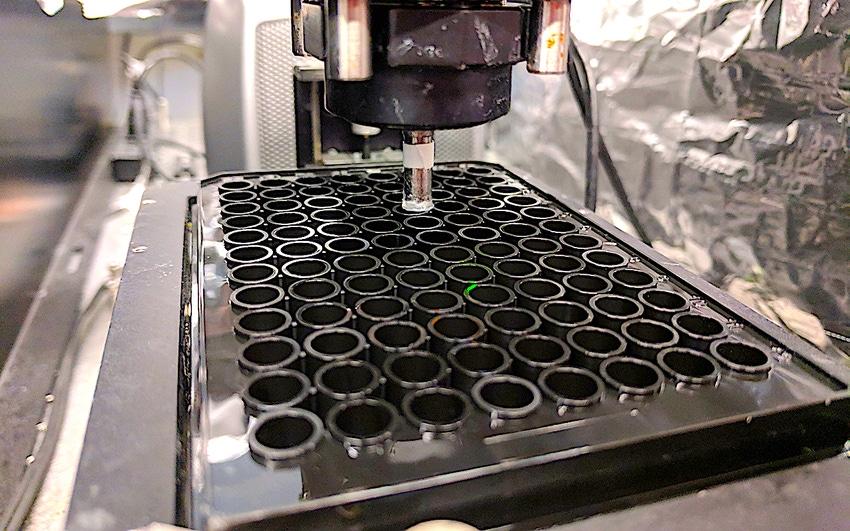The platform can be used to speed up the process of testing and approving new medications for clinical and commercial use.
July 6, 2021

Researchers have developed a rapid-production 3D bioprinter that could also speed up the development of new medications by providing living human tissue samples in record time, they said.
A team of nanoengineers at the University of California San Diego (UCSD) led by Shaochen Chen, a professor of nanoengineering at the UC San Diego Jacobs School of Engineering, developed the printer, which can produce a 96-well array of samples within 30 minutes, he said. At this speed, pharmaceutical companies can save a significant amount of time during the preclinical drug screening and disease modeling phases of developing new drugs, researchers said.
The technology builds upon a project led by Chen in 2013 to develop a platform for creating living biological tissues for regenerative medicine. This work has now evolved into the rapid-prototype printing platform, he said.
“With human tissues, you can get better data—real human data—on how a drug will work,” Chen explained in a press statement. “Our technology can create these tissues with high-throughput capability, high reproducibility, and high precision. This could really help the pharmaceutical industry quickly identify and focus on the most promising drugs.”
Indeed, the current process for a pharmaceutical company to develop a new drug can take up to 15 years and cost up to $2.6 billion. It generally begins with screening tens of thousands of drug candidates in test tubes that then go on to animal testing and, if successful, to human clinical trials. All this must happen before the Food and Drug Administration (FDA) approves a drug for widespread use.
With the printing technology Chen and his team developed, drug developers can rapidly build up large quantities of human tissues on which they could test drugs to eliminate candidates and pass successful prospects onto the next phase much sooner than they do now, he said.
How the Tech Works
The high-throughput 3D bioprinting technology developed by the team begins with 3D models of biological structures that are created on a computer; these models can even be modeled from medical scans for personalized patient treatment, researchers said. The computer then parses the models into 2D snapshots and transfers them to millions of microscopic-sized mirrors, which project patterns of violet light at 405 nanometers in wavelength—a safe size for cells.
The next step is where the printing technology comes in, shining these light patterns onto a solution containing live cell cultures and light-sensitive polymers that solidify upon exposure to light. The bioactive solution is rapidly printed one layer at a time in a continuous fashion, resulting in a 3D solid polymer scaffold encapsulating live cells that will grow and become biological tissue, researchers said.
The printer’s high speed comes from the digitally controlled micromirror array, explained Henry Hwang, a nanoengineering Ph.D. student in Chen’s lab who worked on the technology. Because it projects entire 2D patterns onto the substrate as it prints layer by layer, it produces 3D structures much faster than other printing methods, which require scanning each layer line by line using either a nozzle or laser, he said.
“An analogy would be comparing the difference between drawing a shape using a pencil versus a stamp,” Hwang observed in a press statement. “With a pencil, you’d have to draw every single line until you complete the shape. But with a stamp, you mark that entire shape all at once. That’s what the digital micromirror device does in our technology. It’s orders of magnitude difference in speed.”
Other Benefits
In addition to speed, the technology has other benefits for drug testing and development. While the platform won’t eliminate controversial, and what some consider abusive, animal testing altogether, it could minimize failures during this phase of testing and thus find successful drugs faster, precluding further testing at this level, researchers said.
The technology also rivals other 3D bioprinting methods in terms of resolution by printing lifelike structures with intricate, microscopic features--such as human liver cancer tissues containing blood vessel networks, they added. To do this would take about 10 seconds using Chen and his team’s technology while printing the same sample would take hours with other methods, he said.
Another feature of the technology is reproducibility, researchers said. Because the tissues that the printing platform produces are highly organized structures, they can be replicated fairly easily for industrial-scale screening, Chen noted.
This differs from a current approach to grow organoids for drug screening, which has more variables and is limited to unique uses, he explained.
“With organoids, you’re mixing different types of cells and letting them self-organize to form a 3D structure that is not well controlled and can vary from one experiment to another,” he said in a press statement. “Thus, they are not reproducible for the same property, structure, and function. But with our 3D bioprinting approach, we can specify exactly where to print different cell types, the amounts, and the micro-architecture.”
Researchers published a paper on their work in the journal Biofabrication. Chen and a nanoengineering Ph.D. alumnus from his lab, Wei Zhu, also have formed a spin-off company from UC San Diego to commercialize the technology called Allegro 3D Inc., which recently launched its flagship product.
Elizabeth Montalbano is a freelance writer who has written about technology and culture for more than 20 years. She has lived and worked as a professional journalist in Phoenix, San Francisco and New York City. In her free time she enjoys surfing, traveling, music, yoga and cooking. She currently resides in a village on the southwest coast of Portugal.
About the Author(s)
You May Also Like



